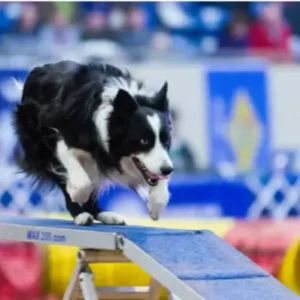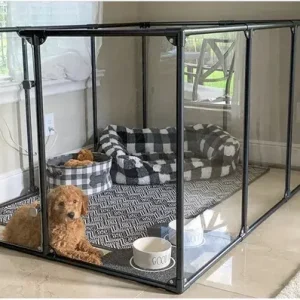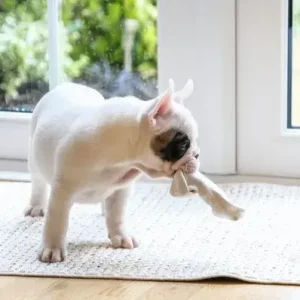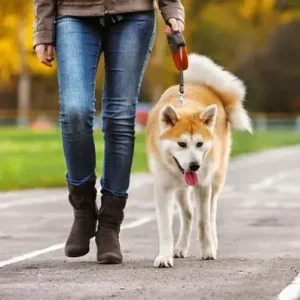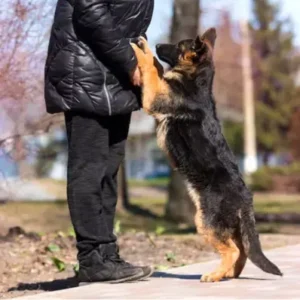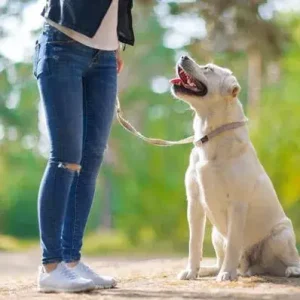Popular Methods for Potty Training
Potty training is a crucial aspect of raising a well-behaved and house-trained puppy. Different methods cater to various lifestyles and preferences. Here are three popular approaches:
Crate Training
Crate training is a widely endorsed method by dog trainers and veterinarians. It capitalizes on a dog’s natural aversion to soiling their living space. The key steps include:
- Introduction: Familiarize your puppy with the crate gradually, associating it with positive experiences.
- Positive Reinforcement: Reward your puppy for entering the crate voluntarily, creating a positive association.
- Scheduled Breaks: Follow a consistent schedule for potty breaks, gradually increasing the time spent in the crate.
Crate training instills discipline, aids in bladder control, and provides a secure environment for your puppy.
Paper Training
Paper training is a suitable option for pet owners who may not have immediate outdoor access or those with small breeds. Here’s how to implement paper training effectively:
- Designated Area: Allocate a specific indoor area for your puppy’s bathroom needs, preferably lined with training pads.
- Positive Reinforcement: Praise and reward your puppy for using the designated area, reinforcing good behavior.
- Transition to Outdoors: Gradually shift the training pads closer to the door, encouraging a natural transition to outdoor potty habits.
Paper training is a practical solution for those unable to take their puppy outside frequently.
Indoor Potty Training
For apartment dwellers or those in extreme weather conditions, indoor potty training can be an ideal choice. Here’s how to implement this method:
- Use of Indoor Litter: Utilize indoor litter boxes designed for dogs, providing a familiar substrate for potty needs.
- Consistent Placement: Place the indoor potty area in a consistent location, facilitating routine for your puppy.
- Positive Reinforcement: Reward your puppy for using the indoor potty area, reinforcing the desired behavior.
Indoor potty training is convenient for those without immediate outdoor access, allowing flexibility in challenging environments.
Each method has its merits, and the choice depends on your lifestyle, living situation, and the needs of your puppy. Incorporating other dog training tips, such as positive reinforcement and patience, will further help your puppy become a well-adjusted and respectful companion.
Tips for Crate Training Your Puppy
Crate training is a process of teaching your puppy to associate a crate with safety, comfort, and security. It is a valuable tool that can help your puppy learn to control their bladder and bowels and reduce the risk of accidents in the house.
Here are some tips on how to potty train a puppy using a crate:
Choosing the Right Crate
The crate should be large enough for your puppy to stand up, turn around, and lie down comfortably. It should not be too big, as this may encourage your puppy to use one corner for elimination and settle down away from the mess. A crate with a divider panel can be adjusted as your puppy grows.
Introducing Your Puppy to the Crate
Introduce your puppy to the crate gradually, using positive reinforcement techniques such as treats and toys. Start by placing the crate in a quiet area of your home and leaving the door open. Encourage your puppy to explore the crate by placing treats and toys inside. Once your puppy is comfortable entering the crate, start closing the door for short periods while you are at home.
Creating a Feeding Schedule
Establishing a consistent feeding schedule can help regulate your puppy’s bowel movements and make it easier to predict when they need to go potty. Feed your puppy at the same time every day and remove their food bowl after 20-30 minutes.
Supervising Your Puppy
Supervise your puppy at all times when they are outside the crate. Watch for signs that your puppy needs to go potty, such as sniffing, circling, or starting to squat. Take your puppy to their designated potty spot immediately.
Teaching Your Puppy to Signal
Teach your puppy to signal when they need to go potty by using a bell or other sound. Hang the bell on the door handle and ring it every time you take your puppy outside to go potty. Eventually, your puppy will learn to ring the bell when they need to go outside.
Avoiding Punishment
Never punish your puppy or dog for accidents or mistakes. Punishment can cause fear and anxiety, which can make potty training more difficult.
Gradual Transition from Crate to Freedom
Once your puppy is house-trained, you can gradually increase their freedom by allowing them to spend more time outside the crate. Start by leaving the crate door open while you are at home, and eventually, you can leave the dog crate door open when you are away.
Time Your Puppy Should Spend in the Crate
A young puppy can typically hold their bladder for one hour per month of age, up to a maximum of 8 hours. Use this as a guideline for how long your puppy can spend in the crate without needing to go potty.
Enzymatic Cleaners for Accidents
Accidents are bound to happen during the potty training process. Use enzymatic cleaners to clean up any messes, as these cleaners break down the enzymes in urine and feces that can cause lingering odors.
Remember, potty training takes time and patience. With consistent training and positive reinforcement, your puppy will soon be house-trained and ready to enjoy their new home with you!
How To Potty Train A Puppy Without A Crate?
While crate training is very helpful and common, it’s also important to explore alternative methods for how to potty train a puppy fast. Here are some general tips for potty training your puppy:
- Define a Designated Potty Area
Select a consistent outdoor space for your puppy’s bathroom needs. This establishes a routine and reinforces positive habits.
- Outdoor Breaks with Consistent Timing
Maintain a schedule for frequent outdoor breaks, especially after meals, play, and naps. This routine helps manage the time between potty breaks.
- Embrace Positive Reinforcement
Praise and treat your puppy promptly after they use the designated potty area. Positive reinforcement encourages good behavior without the use of a crate.
- Establish a Regular Feeding Schedule
Implement a consistent feeding schedule. Knowing when your puppy will need to go outside aids in planning effective potty breaks.
- Indoor Supervision
Keep close watch indoors to redirect your puppy to the designated outdoor potty area, avoiding accidents. This method doesn’t rely on crate confinement.
- Recognize Puppy Signals
Be attentive to your puppy’s behavior, identifying signs indicating the need to go outside. This step is crucial for timely potty breaks.
- Explore Indoor Potty Options
Consider alternatives like training pads or indoor grass patches designed for dogs. Useful in challenging weather conditions, these options align with a crate-free approach.
- Prompt Cleaning of Accidents
Accidents may happen, so clean promptly with enzymatic cleaners. Thorough cleaning deters repeat behavior, maintaining a clean living environment.
- Teach Verbal Cues
Introduce specific verbal cues or commands associated with potty time. Consistent use of cues aids communication and training without relying on a crate.
- Celebrate Successful Potty Visits
Acknowledge and celebrate your puppy’s achievements in the designated potty area. Positive reinforcement is a powerful tool for training, even without crate use.
This method emphasizes the importance of time management between potty breaks and incorporates trainer-recommended techniques.



